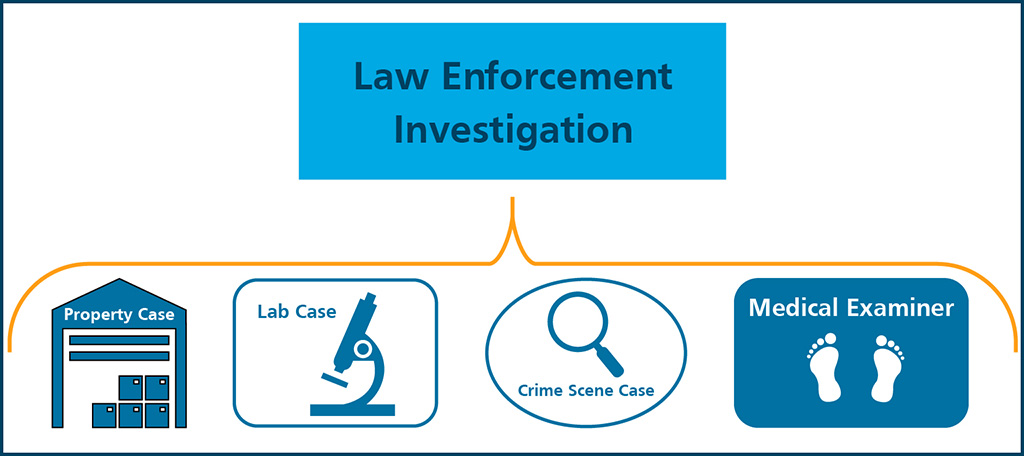 Our crime scene: A victim has been murdered in the local park.
Our crime scene: A victim has been murdered in the local park.
The police Crime Scene Unit collects shell casings from a fired weapon.
The body is transported to the Medical Examiner’s office where a projectile is removed from the torso.
The victim’s clothing is bagged and sent to Property & Evidence.
Meanwhile, a suspect is apprehended and the firearm in his possession is sent directly to the Crime Laboratory.
So what we have now is the crime lab, medical examiner, property room, and crime scene unit each with their own unique numbering systems to identify the same case. It’s also likely that the first piece of evidence each team handles will be assigned the number “1”.
To further complicate this scenario, if the case goes to trial, the Court will assign two more numbers to each piece of evidence: one number when it is presented and another once it is moved into evidence.
This hypothetical example illustrates how the evidence tracking process often creates confusion. A single piece of evidence for a given crime can have multiple numbers, and different pieces of evidence may have the same number depending on their point of origin. This confusion can slow an investigation down, lead to errors, and even threaten the case with faulty chain of custody.
But it doesn’t have to be that way.
Overcoming “Murder by Numbers”
In a criminal investigation, every detail counts and any mistake can tip the scales of justice. Yet as we’ve shown, the path of evidence from crime scene to courtroom is fraught with potential for confusion and error.
Evidence can be collected at many different points in the investigative process, including the crime scene, the medical examiner’s office, the property and evidence warehouse, a submission portal, and the crime lab itself. In some agencies these stakeholders use separate systems to track the evidence.
The challenge arises when the evidence then moves from one to the other. Even the simple scenario presented above can start to look complicated very quickly:
| Evidence | Created in the LIMS by | Sent To |
| Shell Casings | Crime Scene | Forensic Lab |
| Projectile/Bullet | Medical Examiner’s Office | Forensic Lab |
| Clothing | Medical Examiner’s Office | Property Room |
| Firearm | Forensic Lab | N/A |
Evidence collection and investigation example
But what if each of these stakeholders were connected to a single integrated system? Evidence could be entered into a central Forensic Information Management System from any point at any time without creating unnecessary confusion.

Imagine how efficient your workplace could be if this maze of evidence numbers and multiple tracking systems converged into a single, streamlined evidence management flow. In an environment like this, every piece of evidence could be accounted for, and every identification number would tell a clear and easily traceable story.
LabVantage Forensic Navigator offers a simple solution for bringing this vision into reality.
The Case for Forensic LIMS Integration
Pre-configured for forensic organizations, the LabVantage Forensic Navigator eliminates the confusion that arises when tracking evidence that originates from different places and is transferred among multiple stakeholders.
Forensic Navigator goes beyond the traditional laboratory LIMS by enabling law enforcement to enter data in real time, make examination requests and check status from a secure web-based portal. As the investigation continues, every stakeholder involved — property management, forensic lab analysis, medical examiner, investigative activities, legal proceedings — has access to this single platform, ensuring accurate, secure data management and analysis.

In this workflow, all evidence is tagged according to the investigative agency where it originates and linked to the investigative agency ID (IA/IA case number). The IA/IA case number then becomes the backbone of the case—a common thread running through every point where evidence can enter the system.
By linking the evidence back to the IA/IA case number, the LIMS is aware of each exhibit as it is created and assigns it the next sequential number, ensuring that every item is uniquely identified for all stakeholders with the same identification number.
Forensic Navigator also eliminates data silos, enabling anyone with the proper authorization to see all submitted evidence across the entire investigation. In addition, you have the option to use artificial intelligence to analyze and extract insights from vast collections of forensic data.
Examine the Evidence for Yourself
LabVantage Forensic Navigator can help your organization seamlessly manage evidence and case identifiers across your entire organization. And that’s not all it does! Learn how the Forensic Navigator can help your organization by scheduling a demo today.



